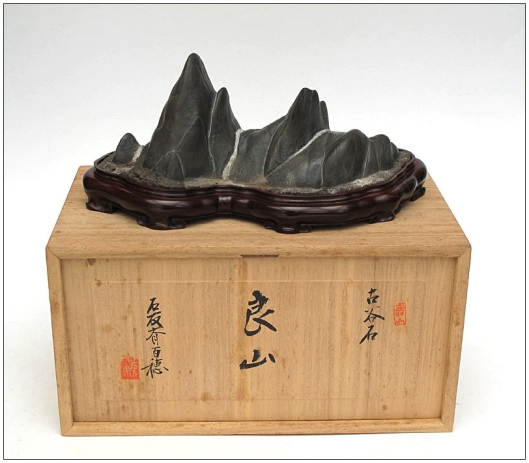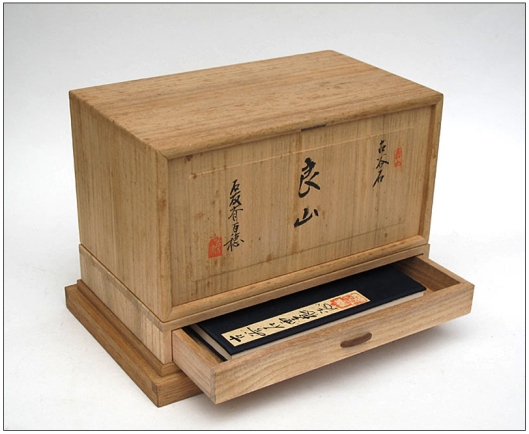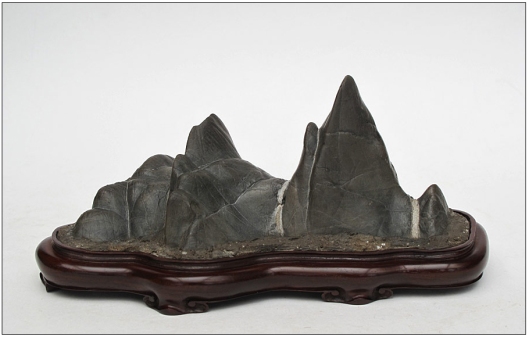Tanimoto Hyakusui was a well known collector and seller of Furuya stones and was considered by many to be an expert on these stones. It is rare to find a stone from his collection that is also double-boxed with an album.

Ryozan literally means “fine mountains” which seems appropriate for the much smoother and fine examples of a Furuya stone like this particular one.

This set included a double box. The outer box is made to protect the inner box which contains the various signatures of is owners and the name and type of stone. The brown and green ribbon used to close the box was one of Tanimoto’s signatures. Some double boxed stones have the outer box made in highly polished lacquer, but that is not the case for this stone.

Inside the outer box we find the box containing the stone and a secondary layer that contains the album.
Inscribed on the box lid from right to left is, “Furuya-ishi’, the two large characters in the center is the stone’s name Ryozan and to the left is Tanimoto’s “Sekiyusai Hyakusui” signature.

The album’s outer label reads “Furuya ishi Unkon shi” which means Furuya ishi Stone Record or Album, followed by Tanimoto’s Hyakusui seal. This was a part of the literati tradition dating back to the Edo period of Japan, where honored guests who viewed the stone were asked to paint a picture, write a poem, or record their thoughts.

In this instance, Tanimoto himself furnished the stone with the album and wrote the first inscription – it would have been left to future owners to inscribe, or invite others to do so, yet as can be seen no other inscriptions follow that of Tanimoto.
Tanimoto’s entry is written in Kanbun, which is a Japanese attempt at reproducing classical Chinese, and is therefore very difficult to understand without specialized training. It seems to say something to the effect of, “Simply placed in the alcove of a room, one cannot help but feel the great wonder inspired by these strange stones (kiseki).” This Chinese style entry and the use of the word “kiseki” rather than suiseki adds to the literati atmosphere of the set.




The daiza was carved from rosewood in Japan and is signed by the maker “Kaidou” who was a very fine carver from that time period. Tanimoto was known to carve daizas himself, however, later in life he lacked the strength to carve them in hardwood with precision, so many of his daizas in that period were commissioned to other carvers.
This stone was not in his book that he co-authored with Murata Keiji in 1969 entitled An Overview of Furuya ishi Masterpieces. Coupled with the signature on the outside of the box “Sekiyusai Hyakusui” it is assumed he had this piece after the publication of the book, therefore one can assume likely in the 1970s or early 1980s as he used that artistic name late in his career.
The stone was acquired from a preeminent collector outside of Japan and our thanks to him for such detailed information on the stone and its history.
It is our hope that this recording of provenance is something each serious collector will consider. We have started having kiri-boxes made with the drawer for an album to be stored. Two of them are making their way from Japan to our home as this article is being written. Once they arrive, another article will be written showing where you can find albums to record your own stone’s history.

Lovely stone Sam!